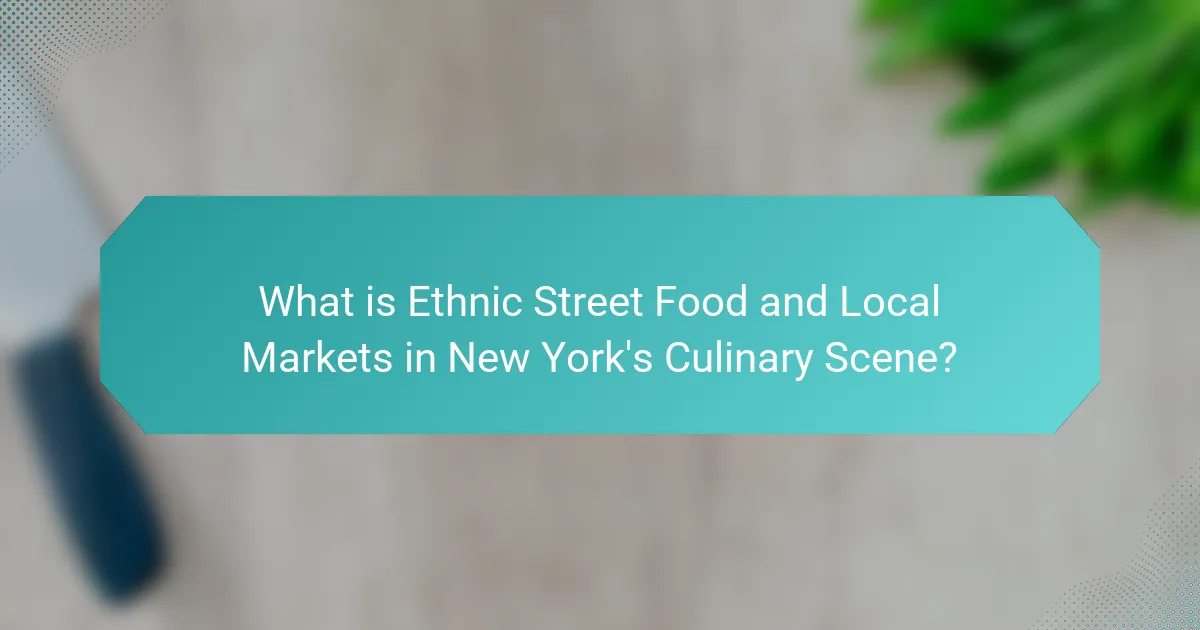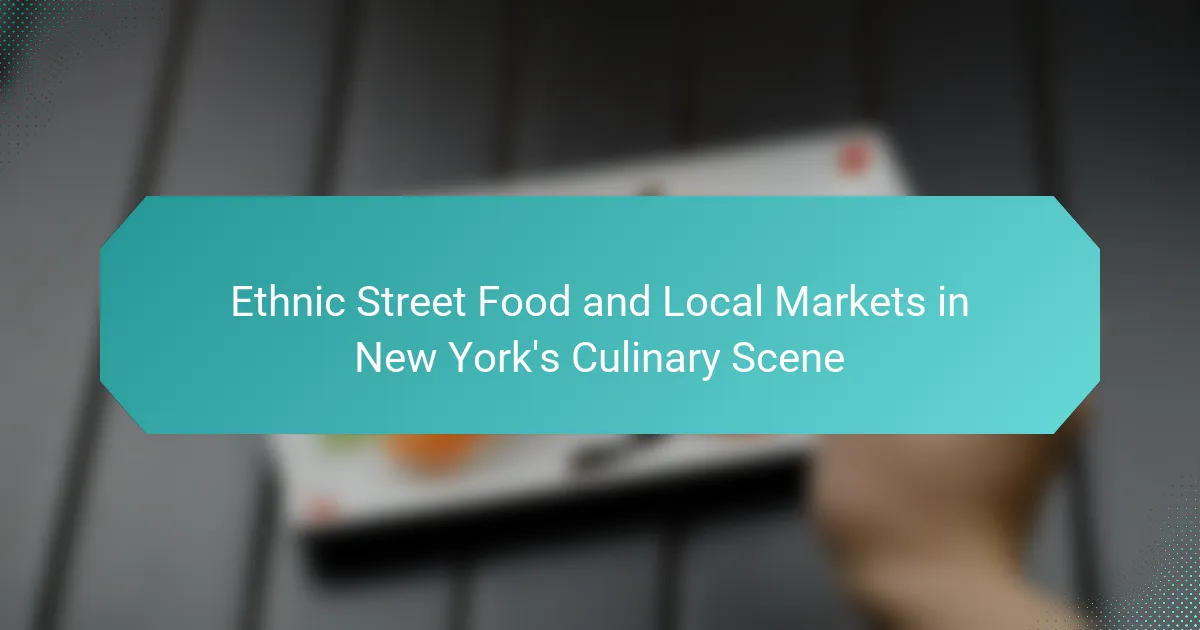Ethnic street food and local markets in New York City showcase the city’s rich culinary diversity, reflecting its multicultural heritage. Vendors from various countries offer authentic dishes such as tacos, dumplings, falafel, and more, creating a vibrant food scene. Key local markets include Queens Night Market, Smorgasburg, and Essex Street Market, each providing unique platforms for food entrepreneurs and artisanal goods. These markets not only serve as community hubs but also celebrate the diverse flavors that contribute to New York’s dynamic culinary landscape, attracting both locals and tourists.

What is Ethnic Street Food and Local Markets in New York’s Culinary Scene?
Ethnic street food and local markets in New York’s culinary scene represent diverse global cuisines. They offer a vibrant tapestry of flavors and dishes from various cultures. Vendors often originate from different countries, bringing authentic recipes to the streets. Popular items include tacos, dumplings, and falafel. Local markets serve as community hubs, showcasing fresh produce and artisanal goods. They provide a platform for small businesses and food entrepreneurs. The city’s rich immigrant history contributes to this culinary diversity. Events and festivals celebrate these foods, attracting locals and tourists alike.
How did Ethnic Street Food and Local Markets evolve in New York?
Ethnic street food and local markets in New York evolved through waves of immigration and cultural exchange. In the late 19th and early 20th centuries, immigrants brought diverse culinary traditions. This led to the establishment of local markets catering to specific ethnic communities. By the 1970s, food trucks began to emerge, offering accessible ethnic cuisine. The growth of multicultural neighborhoods further fueled demand for diverse food options. In recent years, food festivals have popularized ethnic street food, showcasing various cultures. Today, New York’s street food scene reflects its rich tapestry of global influences. The city’s commitment to diversity has solidified its reputation as a culinary hub for ethnic cuisines.
What historical factors contributed to the rise of Ethnic Street Food?
The rise of ethnic street food is influenced by several historical factors. Immigration has played a significant role in introducing diverse culinary traditions. As various ethnic groups settled in urban areas, they brought their traditional foods with them. Economic factors also contributed, as street food often provides affordable dining options for low-income populations. Additionally, globalization has facilitated cultural exchange and the popularity of international cuisine. Urbanization has led to increased foot traffic in cities, creating demand for convenient food options. Food markets and festivals have further promoted ethnic street food by showcasing diverse offerings. These factors collectively shaped the vibrant street food culture seen today.
How do local markets support ethnic cuisines in New York?
Local markets in New York support ethnic cuisines by providing access to diverse ingredients and authentic products. These markets cater to various communities, allowing them to find familiar foods. They host vendors who specialize in specific ethnic cuisines, enhancing cultural representation. Local markets often feature food stalls that offer traditional dishes, making them accessible to a wider audience. Events and festivals at these markets celebrate cultural heritage through food. This creates a vibrant culinary scene that attracts both locals and tourists. By showcasing ethnic cuisines, local markets contribute to the preservation of cultural identities. They also promote economic growth for small businesses within these communities.
What role does Ethnic Street Food play in New York’s culture?
Ethnic street food is a vital component of New York’s culture. It reflects the city’s diverse population and multicultural identity. Food vendors offer a range of cuisines from various countries. This accessibility fosters cultural exchange among residents and tourists. Street food markets serve as social hubs, promoting community engagement. According to the New York City Department of Health, there are over 5,000 food vendors citywide. These vendors contribute significantly to the local economy. Ethnic street food enhances the culinary landscape, showcasing global flavors.
How does Ethnic Street Food reflect the diversity of New York’s population?
Ethnic street food reflects the diversity of New York’s population by showcasing a wide array of cultural cuisines. Vendors from various ethnic backgrounds offer dishes that represent their heritage. For instance, you can find tacos from Mexican communities, dumplings from Chinese immigrants, and halal food from Middle Eastern vendors. This variety highlights the city’s multicultural fabric. According to the New York City Department of Health, there are over 20,000 street food vendors. Many of these vendors are immigrants, bringing their traditional recipes to the streets. The presence of diverse food options fosters cultural exchange and understanding among residents and visitors.
What cultural traditions are showcased through local markets?
Local markets showcase diverse cultural traditions through food, crafts, and community interactions. These markets often feature ethnic street food that reflects the culinary heritage of various immigrant communities. Vendors sell traditional dishes that are passed down through generations, preserving recipes and cooking techniques. Crafts and handmade goods also represent cultural artistry and craftsmanship unique to each community. Festivals and events held in local markets celebrate cultural holidays and customs, fostering community engagement. Additionally, local markets serve as gathering spaces that promote cultural exchange and understanding among diverse populations. New York’s local markets exemplify this cultural richness, highlighting the city’s multicultural fabric.
Why is Ethnic Street Food popular among New Yorkers?
Ethnic street food is popular among New Yorkers due to its diversity and accessibility. The city boasts a rich tapestry of cultures, leading to a wide variety of food options. Street vendors offer authentic dishes from different countries at affordable prices. This allows residents and tourists to experience global flavors without the need for formal dining. Additionally, the fast-paced lifestyle of New Yorkers suits the quick service provided by street food vendors. According to a study by the New York City Department of Health, street food contributes significantly to the local economy, with thousands of vendors operating citywide. The popularity of ethnic street food reflects New York’s identity as a melting pot of cultures.
What are the unique flavors and dishes that attract locals and tourists?
Unique flavors and dishes in New York’s ethnic street food scene include tacos, dumplings, and halal platters. Tacos from food trucks offer authentic Mexican flavors, featuring fresh ingredients and vibrant salsas. Dumplings, particularly from Chinatown, showcase traditional Chinese recipes, often filled with pork or vegetables. Halal platters, popular among diverse communities, feature seasoned meats over rice with tangy sauces. These dishes are not only flavorful but also reflect the cultural diversity of New York. Local food festivals often highlight these offerings, attracting both locals and tourists. The city’s culinary landscape is enriched by these unique flavors that provide a taste of various cultures.
How does the affordability of street food impact its popularity?
The affordability of street food significantly enhances its popularity. Lower prices attract a diverse range of consumers, including those with limited budgets. Street food often provides quick, convenient meals for busy individuals. This accessibility increases foot traffic at food stalls and markets. For example, studies show that affordable options can lead to higher sales volume. The lower cost also allows for experimentation with different cuisines. Consumers are more willing to try new dishes when the price is reasonable. Overall, affordability is a key factor driving the popularity of street food in urban areas like New York.

What types of Ethnic Street Food can be found in New York?
New York offers a diverse range of ethnic street food. Popular options include tacos from Mexican vendors. You can find halal food carts serving dishes like chicken over rice. There are also Jamaican jerk chicken stands. Additionally, you can enjoy Italian sausage and peppers from street vendors. Korean BBQ tacos are a fusion favorite. Chinese dumplings are frequently sold in various neighborhoods. Vietnamese banh mi sandwiches are also widely available. These options reflect the city’s multicultural culinary scene.
Which cuisines are prominently featured in New York’s street food scene?
New York’s street food scene prominently features cuisines such as Mexican, Chinese, and Middle Eastern. Mexican food includes tacos and tamales, reflecting the city’s vibrant Latino culture. Chinese street food offers dumplings and bao, showcasing traditional Asian flavors. Middle Eastern options like falafel and shawarma highlight the diversity of immigrant communities. Additionally, Indian cuisine is represented through dishes like kebabs and samosas. These cuisines contribute to the rich tapestry of flavors available on New York’s streets. The city’s street food vendors reflect its multicultural identity and culinary innovation.
What are the most popular dishes from various ethnic backgrounds?
Popular dishes from various ethnic backgrounds include tacos from Mexican cuisine, sushi from Japanese cuisine, and curry from Indian cuisine. Tacos are often made with corn tortillas filled with meat, beans, and salsa. Sushi typically consists of vinegared rice paired with raw fish or vegetables. Indian curry features a blend of spices and is often served with rice or bread.
Other notable dishes include pho from Vietnamese cuisine, which is a noodle soup with herbs and meat. Greek moussaka is a baked dish with layers of eggplant, minced meat, and béchamel sauce. These dishes reflect the rich diversity of ethnic culinary traditions found in New York’s local markets.
How do local markets showcase different culinary traditions?
Local markets showcase different culinary traditions by offering diverse food products and preparation methods. Each market reflects the cultural heritage of its vendors. For example, markets in New York often feature Latin American, Asian, and Mediterranean foods. Vendors sell traditional ingredients unique to their cultures. These include spices, vegetables, and meats that are integral to specific cuisines. Cooking demonstrations may also occur, highlighting traditional cooking techniques. Additionally, food festivals in these markets celebrate cultural dishes, drawing attention to culinary diversity. This variety fosters community engagement and appreciation for different food traditions.
How do food trucks and vendors contribute to the street food landscape?
Food trucks and vendors significantly enrich the street food landscape by offering diverse culinary options. They provide accessible and affordable meals to a wide audience. Food trucks often showcase ethnic cuisines, reflecting the multicultural fabric of urban areas. This diversity enhances the local food culture and encourages culinary experimentation. Vendors frequently adapt their menus to seasonal ingredients and local preferences. This flexibility allows them to respond quickly to changing consumer tastes. Additionally, food trucks contribute to local economies by creating jobs and attracting foot traffic. Their presence fosters community engagement through food festivals and events. Overall, food trucks and vendors are essential in shaping vibrant street food scenes.
What are the regulations and permits required for street food vendors?
Street food vendors must obtain several permits and adhere to regulations. They require a food vendor license issued by the New York City Department of Health and Mental Hygiene. Vendors must also obtain a mobile food vending permit. Compliance with health and safety regulations is mandatory, including food handling and sanitation standards. Additionally, vendors need a business license and may require a sales tax certificate. Local zoning laws can impact where vendors can operate. Regular inspections ensure adherence to these regulations. Failure to comply can result in fines or permit revocation.
How do food trucks differentiate themselves in a competitive market?
Food trucks differentiate themselves in a competitive market through unique menus, branding, and customer engagement. Many food trucks offer specialized cuisines that reflect ethnic diversity. This approach attracts specific customer segments seeking authentic flavors. Creative branding, including eye-catching designs and memorable names, enhances visibility. Engaging with customers via social media builds a loyal following. Some trucks also participate in food festivals and local events to increase exposure. According to a 2020 report by IBISWorld, the food truck industry has seen a 7.5% annual growth rate, indicating strong competition. Effective differentiation strategies are essential for success in this growing market.

What are the best local markets for experiencing Ethnic Street Food?
The best local markets for experiencing ethnic street food in New York include Queens Night Market, Smorgasburg, and the Essex Street Market. Queens Night Market features a diverse range of international cuisines from over 60 vendors. It operates seasonally and showcases local artisans and food entrepreneurs. Smorgasburg is known for its weekend food market with around 100 local vendors offering various global dishes. The Essex Street Market provides a year-round venue with a mix of traditional and modern food stalls, highlighting diverse culinary traditions. Each market reflects New York’s multicultural identity and offers unique tasting experiences.
Which markets are must-visit for street food enthusiasts?
Smorgasburg and Queens Night Market are must-visit markets for street food enthusiasts. Smorgasburg operates in Williamsburg and Prospect Park. It features over 100 local vendors offering diverse cuisines. Queens Night Market showcases international food from various cultures. It operates seasonally and highlights local chefs and home cooks. Both markets attract thousands of visitors weekly. They provide unique culinary experiences not found elsewhere.
What unique offerings can be found at these local markets?
Local markets in New York offer unique ethnic street foods that reflect diverse cultures. Vendors provide authentic dishes from various regions. Examples include Mexican tacos, Jamaican jerk chicken, and Indian samosas. Each dish showcases traditional recipes and ingredients. Many vendors source their produce locally, ensuring freshness. Unique offerings often include fusion foods, blending different culinary traditions. Seasonal ingredients influence the menu, adding variety throughout the year. Local markets also feature handmade goods, enhancing the shopping experience.
How do the atmospheres of these markets enhance the dining experience?
The atmospheres of ethnic street food markets in New York enhance the dining experience by creating a vibrant and immersive environment. These markets often feature colorful stalls and lively vendors, which stimulate the senses. The sounds of cooking and chatter among patrons contribute to a dynamic atmosphere. The aromas of diverse cuisines fill the air, enticing diners to explore various food options. Additionally, communal seating encourages social interaction and sharing among guests. Cultural decorations and music reflect the heritage of the cuisines offered, enhancing the authenticity of the experience. Research shows that sensory stimulation significantly impacts dining satisfaction, making the market experience memorable. Overall, the unique atmospheres of these markets elevate the enjoyment of ethnic street food.
How can visitors navigate New York’s street food scene effectively?
Visitors can navigate New York’s street food scene effectively by using mobile apps and local guides. These resources provide real-time information on food truck locations and vendor reviews. Popular apps like Yelp and Street Food Finder help users discover highly-rated options. Exploring neighborhoods known for street food, such as Queens and Brooklyn, enhances the experience. Additionally, attending food festivals can showcase diverse offerings. Engaging with vendors can provide insights into the food’s cultural background. New York’s street food scene features over 2,000 food vendors, offering a wide range of cuisines. This variety allows visitors to sample authentic dishes from around the world.
What tips should newcomers keep in mind when exploring local markets?
Newcomers should prioritize engaging with vendors at local markets. This interaction enhances the shopping experience and provides insights into the products. Sampling food items is essential; it allows newcomers to discover unique flavors. Observing local customs and etiquette is also important. Each market may have specific unwritten rules. Arriving early can help avoid crowds and ensure the best selection. Carrying cash is advisable, as some vendors may not accept cards. Researching the market’s schedule and featured vendors can enhance the visit. Lastly, being open to trying new foods fosters a richer culinary experience.
How can food lovers discover hidden gems among street vendors?
Food lovers can discover hidden gems among street vendors by exploring diverse neighborhoods. Visiting areas with rich cultural backgrounds often leads to unique culinary experiences. Engaging with local communities provides insights into their favorite vendors. Social media platforms and food blogs frequently highlight underrated street food spots. Participating in food tours can also introduce food lovers to lesser-known vendors. Observing foot traffic can indicate popular and authentic options. Additionally, seeking recommendations from residents enhances the chances of finding hidden gems. According to a report by the New York City Department of Health, street vendors contribute significantly to the city’s vibrant food scene, making exploration worthwhile.
What common challenges do street food vendors face in New York?
Street food vendors in New York face several common challenges. One significant challenge is obtaining the necessary permits and licenses. The city has strict regulations governing street food operations. Vendors often struggle with compliance due to the complexity of these regulations. Another challenge is competition for prime locations. High foot traffic areas are highly sought after, making it difficult for some vendors to secure spots. Additionally, vendors face unpredictable weather conditions that can affect sales. Seasonal fluctuations also impact customer turnout, with colder months seeing reduced business. Moreover, health inspections can pose challenges, as vendors must maintain strict hygiene standards. Lastly, rising costs for ingredients and supplies can squeeze profit margins. These factors collectively create a challenging environment for street food vendors in New York.
How do seasonal changes affect the availability of ethnic street food?
Seasonal changes significantly impact the availability of ethnic street food. In warmer months, vendors often sell a wider variety of fresh produce and ingredients. This is due to the abundance of seasonal fruits and vegetables that influence menu offerings. For instance, summer brings items like mangoes and corn, which are popular in many ethnic cuisines. Conversely, colder months may limit ingredient availability, leading to a focus on heartier dishes. Winter often sees vendors offering warming foods such as soups and stews. Additionally, weather conditions can affect foot traffic and vendor operations. Rain or snow may reduce customer turnout, impacting sales and food variety. Overall, seasonality dictates both the types of food available and the operational dynamics of street food vendors.
What strategies do vendors use to overcome competition and attract customers?
Vendors in ethnic street food and local markets in New York use several strategies to overcome competition and attract customers. They often focus on unique offerings that highlight cultural authenticity. This differentiation helps them stand out in a crowded market. Many vendors also engage in social media marketing to reach potential customers effectively. Promotions, such as discounts or special deals, are commonly utilized to entice new patrons. Additionally, vendors often participate in local events or festivals to increase visibility. Quality ingredients and exceptional customer service are prioritized to build customer loyalty. Collaborations with local businesses can enhance their reach and attract diverse clientele. These strategies collectively help vendors thrive in a competitive environment.
Ethnic street food and local markets in New York’s culinary scene represent a diverse array of global cuisines, showcasing authentic dishes from various cultures brought by immigrant vendors. This article explores the evolution of ethnic street food, highlighting historical factors such as immigration and globalization, and examines how local markets support these culinary traditions by providing access to unique ingredients and fostering community engagement. Key topics include the role of food trucks, popular dishes, and the challenges faced by vendors, as well as recommendations for visitors to navigate and enjoy New York’s vibrant street food landscape.
